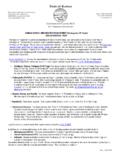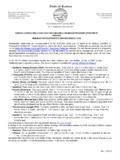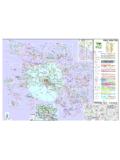Transcription of H A N D B O O K - WHO | World Health Organization
1 SECOND. EDITION. Special Programme for Research & Training in Tropical Diseases (TDR) sponsored by UNICEF/UNDP/ World Bank/WHO. HANDBOOK. GOOD LABORATORY. PRACTICE (GLP). Quality practices for regulated non-clinical research and development WHO Library Cataloguing-in-Publication Data Handbook: good laboratory practice (GLP): quality practices for regulated non-clinical research and development - 2nd ed. - Organization and administration. - handbooks. techniques and procedures. Bank/WHO Special Programme for Research and Training in Tropical Diseases. ISBN 978 92 4 154755 0 (NLM classification: QY 25). Copyright World Health Organization on behalf of the Special Programme for Research and Training in Tropical Diseases 2009. All rights reserved. The use of content from this Health information product for all non-commercial education, training and information purpos- es is encouraged, including translation, quotation and reproduction, in any medium, but the content must not be changed and full acknowledgement of the source must be clearly stated.
2 A copy of any resulting product with such content should be sent to TDR, World Health Organization , Avenue Appia, 1211 Geneva 27, Switzerland. TDR is a World Health Organization (WHO) executed UNICEF/UNDP/ World Bank/ World Health Organization Special Programme for Research and Training in Tropical Diseases. The use of any information or content whatsoever from it for publicity or advertising, or for any commercial or income-gen- erating purpose, is strictly prohibited. No elements of this information product, in part or in whole, may be used to promote any specific individual, entity or product, in any manner whatsoever. The designations employed and the presentation of material in this Health information product, including maps and other illustrative materials, do not imply the expression of any opinion whatsoever on the part of WHO, including TDR, the au- thors or any parties cooperating in the production, concerning the legal status of any country, territory, city or area, or of its authorities, or concerning the delineation of frontiers and borders.
3 Mention or depiction of any specific product or commercial enterprise does not imply endorsement or recommendation by WHO, including TDR, the authors or any parties cooperating in the production, in preference to others of a similar nature not mentioned or depicted. The views expressed in this Health information product are those of the authors and do not necessarily reflect those of WHO, including TDR. WHO, including TDR, and the authors of this Health information product make no warranties or representa- tions regarding the content, presentation, appearance, completeness or accuracy in any medium and shall not be held liable for any damages whatsoever as a result of its use or application. WHO, including TDR, reserves the right to make updates and changes without notice and accepts no liability for any errors or omissions in this regard. Any alteration to the original content brought about by display or access through different media is not the responsibility of WHO, including TDR, or the authors.
4 WHO, including TDR, and the authors accept no responsibility whatsoever for any inaccurate advice or information that is provided by sources reached via linkages or references to this Health information product. Printed in Switzerland Design: Lisa Schwarb Layout: OnProd, Lausanne HANDBOOK. GOOD LABORATORY PRACTICE. (GLP). Quality practices for regulated non-clinical research and development FOREWORD. In order to assist countries in conducting non-clinical research and drug development, TDR developed a Good Laboratory Practices (GLP) series in 2001, comprising a GLP Handbook as well as GLP Training manuals for trainers and trainees. The demand for this series was so substantial that it became one of the most frequent hits . on the TDR website, generating interest and demand for a second edition. This Second-edition GLP series is presented here in a revised and updated format. It supports continued tech- iii nology transfer and capacity-building in disease endemic countries (DECs) in line with the aims of the recent World Health Assembly Resolution (WHA ) on a Global strategy and plan of action on public Health , innovation and intellectual property ( ).
5 This Second-edition GLP Handbook contains all of the required support material for implementing GLP in a laboratory. The handbook comprises four parts, all updated, including: 1) explanation of the fundamentals of GLP; 2) support for GLP training; 3) meth- odology for GLP implementation in DEC research institutions; 4) GLP principles and guid- ance produced by the Organisation of Economic Co-operation and Development (OECD), and reproduced here with OECD permission. Since publication of the initial GLP edition, TDR-fostered GLP training efforts throughout the World , and particularly in Asia, Latin America and Africa, have led to the formation of a network of GLP trainers. These trainers, acting as testers and critics, had a significant impact on the revision and expansion of this Second-edition GLP series, and particularly in the creation of a section on stepwise' implementation of GLP, identifying clear milestones for the process. A key aim of TDR is to empower disease endemic countries to develop and lead research activities at internationally-recognized standards of quality.
6 This revised GLP. series will support that goal, assisting DEC institutions in performing research and drug development studies to international standards. This, in turn, will also help institutions continue research initiatives into the clinical phases of development, in partnership with both the public and private sectors. GLP HANDBOOK Foreword We anticipate that the use of these GLP resources will help promote cost-effective and efficient preclinical research with a long term positive effect on the development of prod- ucts for the improvement of human Health . In this way, the revised GLP series contributes to TDR's primary mission of fostering an effective global research effort on infectious diseases of poverty in which disease endemic countries play a pivotal role . Dr R. Ridley iv Director TDR. The Development of this Handbook To enjoy the advantages of new or improved methods for the control of tropical dis- eases, disease endemic countries (DECs) will need to rely to a large extent on their own research activities.
7 It is therefore necessary to strengthen the capacity of these countries to conduct research and drug product development studies at a level comparable to that in other parts of the World . The pertinent regulations in the preclinical scenario are the Good Laboratory Practice (GLP) regulations. These regulations are the subject of this handbook, which is a reference and support document, to help in the implementation of GLP. The Principles of Good Laboratory Practice of the Organisation for Economic Cooperation and Development v (OECD) form the basis of this series of guidance documents. This is the second version of the WHO Handbook on GLP. It is the result of experience gained since the first version was published. It also refers to material related to GLP devel- opments over the last seven years. Since the publication of the first GLP Handbook and training manuals, many training programmes have been conducted all over the World . The WHO-TDR Network of GLP Trainers was formed to continue propagating training and implementation of GLP in DECs.
8 The network recommended the revision of this guidance document in order to reflect the progress in international GLP. The modifications in this second version are as indicated below: Chapter 1. Introduction to the WHO/TDR Handbook on GLP has been the subject of minor modifications to help understanding and facilitate reading. Chapter 2. GLP Training: This has been reorganised and updated. The order of the five fundamental points now reads resources characterisation - rules results (instead of documentation) quality assurance . Minor corrections have been made and extra explanations added to this part dealing with the fundamentals of GLP. Notable changes include: New section on the role of the Study Director in the Multi-Site situation. Reference to the prescriptive and descriptive documents in GLP studies. Reference to Principal Investigators. Reference to the Validation of Computerised Systems. New section on the role of Quality Assurance in the Multi-Site situation.
9 GLP HANDBOOK The development Chapter 3. Stepwise implementation now identifies clearer milestones in the process of setting up GLP, as requested by the GLP Network of Trainers. Chapter 4. OECD guidance documents has been expanded to include those published since the first edition of the handbook. These represent entirely new items compared with the first version. At the time of going to press, all the OECD guidance documents on GLP are included in the handbook. The guidance documents are: the application of the OECD Principles of GLP to the organisation and management of multi-site studies;. the application of the principles of GLP to in vitro Studies;. establishment and control of archives that perate in compliance with the principles vi of GLP. Thus, this second edition of the GLP Handbook represents an up-to-date GLP reference document which we trust will be useful to support future deployment of GLP in research centres of DECs. Contributors to the first edition: Scientific Working Group on GLP issues: Dr J.
10 P. Seiler** (International Office for the Control of Medecines (IOCM), Switzerland), Chair Mr D. Long** (GXP Consultant, France), Rapporteur Dr D. Turnheim** (OECD, France) Dr N. Gawadi** (H. Lundbeck, Denmark). Dr N. K. Nair** (University of Sains malaysia, Malaysia). Dr P. Palittaponkarnpim* (National Center for Genetic Engineering and Biotechnology, Thailand). Dr Ch. O. N. Wambebe** (National Institute for Pharmaceutical Research and development, Nigeria). Dr M. T. Ham** (Ministry of Health , Welfare and Sports, The Netherlands Dr A. Walubo* (University of the Orange Free state, South Africa). Mr P. Withers* (Phoenix International, France). Dr G. Murilla* (Kenya Medical Research Institute, Kenya). Dr Sapin* (Agence fran aise de s curit des aliments (AFSSA), France). The development GLP HANDBOOK. Dr Sansanee Chaiyaroj* (Mahidol University, Thailand). Dr M. Arevalo* (Institute de Immunologia del Valle, Colombia). Dr J. F. McCormack* (Food and Drug Administration (FDA), USA).)
















